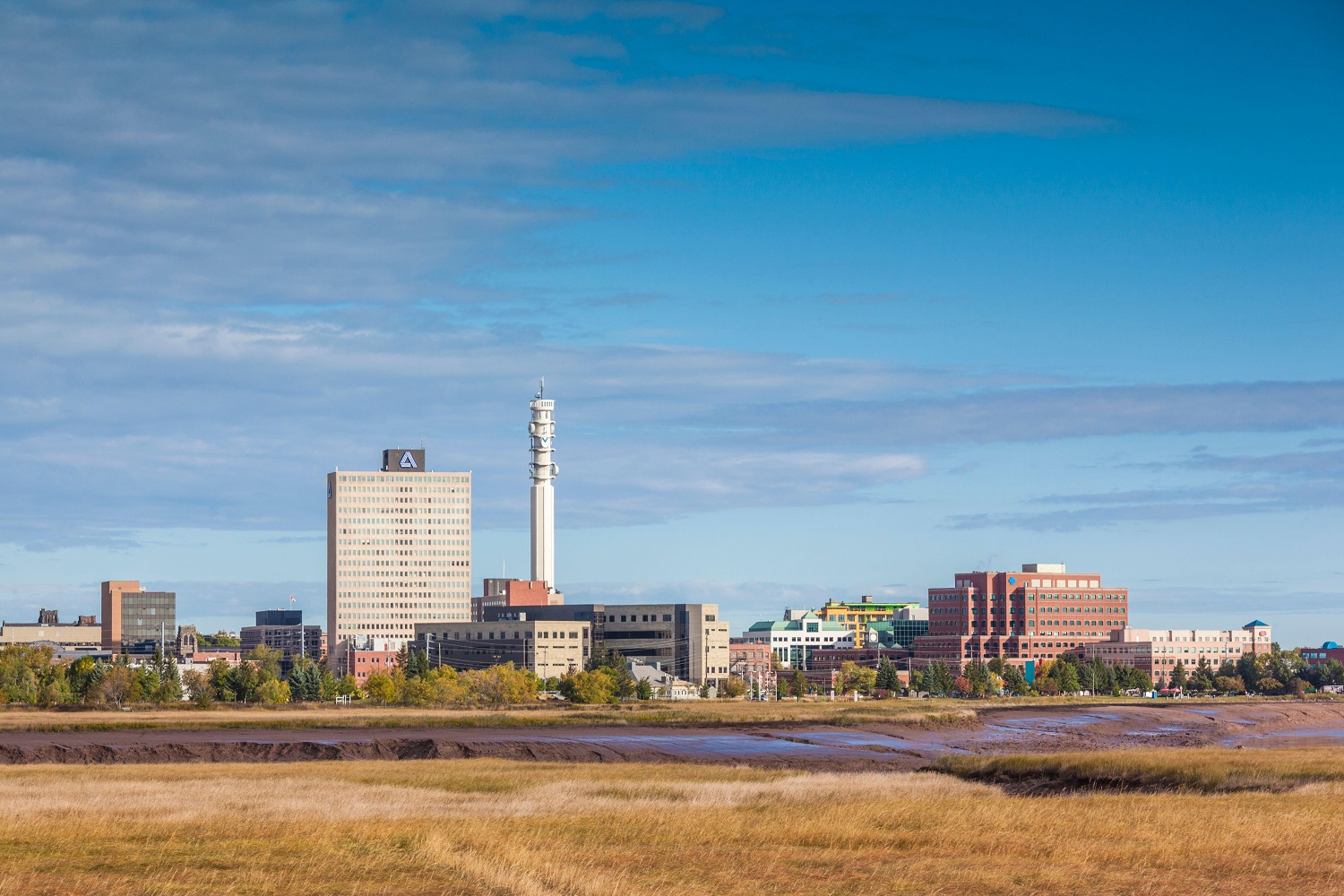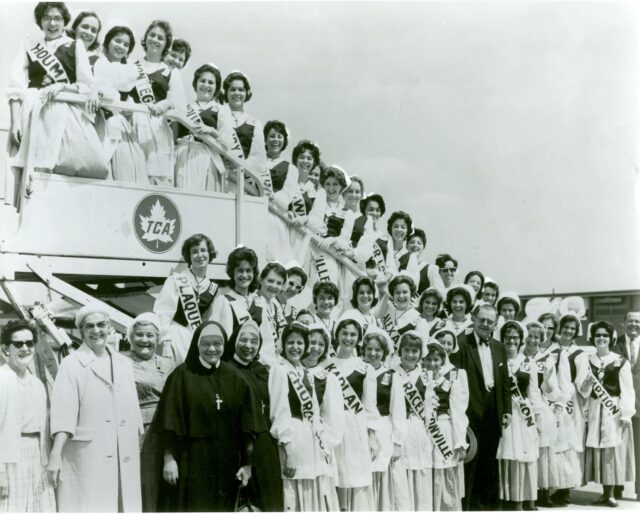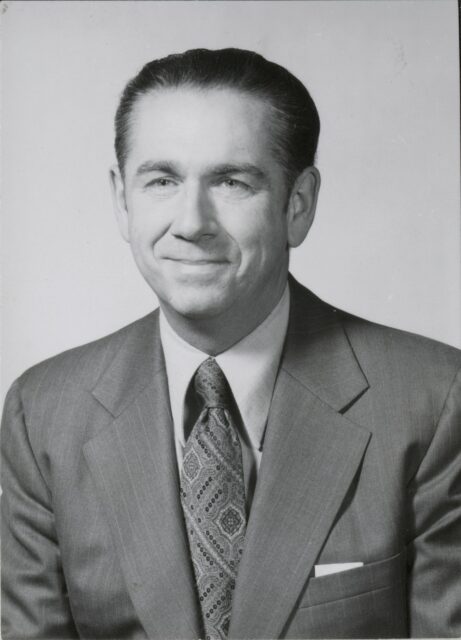A Bilingual Conspiracy?
The controversial kickoff to the twinning between Lafayette and Moncton, New Brunswick
Published: November 29, 2022
Last Updated: March 22, 2023

Photo by Danita Delimont, Alamy Stock Photo
Skyline of Moncton, New Brunswick, with the Petitcodiac River in the foreground.
The beginnings of the twinning between Lafayette, the unofficial capital of Acadiana, and Moncton, New Brunswick, a bilingual city in eastern Canada’s Acadian heartland, did not follow this tidy scenario. Adopted in late 1971 and concluded through reciprocal delegations the following spring, the endeavor was nearly derailed by Moncton’s mayor, Leonard C. Jones, a pro-British traditionalist and English-language supremacist. The story of the sister cities includes an awkward dinner party intended to welcome the Lafayette delegation in Moncton, allegations of international political conspiracy, and—in an incident of failed diplomacy that garnered national press—the mayor of Moncton returning, by post, an “Honorary Acadian” certificate that he had been gifted by his Louisiana guests.
Though at the time it sparked strong reactions, the incident has dimmed from public memory. It is well worth recalling, however. For two centuries, Acadians in Canada faced prejudice, discrimination in employment, education, and the political arena, and even terror through the anti-Catholic crusade of New Brunswick’s Ku Klux Klan in the 1920s. How did a well-meaning banquet turn into a teaching moment about systemic oppression?
I came across the story of the “honorary Acadian” certificate while conducting research on modern-day ties among communities of the Acadian diaspora—that is, groups whose collective identity draws from the historical experience of the Grand Dérangement or “Great Upheaval” following the mass deportation of Acadians by British authorities in the mid-eighteenth century, now recognized as a horrific campaign of ethnic cleansing. The circumstances surrounding Mayor Jones’s actions offer a helpful lens to explore the factors at play when elements of a diasporic collectivity seek to reconnect across borders, political systems, and divergent sociocultural trajectories.
Many folks in Louisiana associate the late 1960s and early 1970s with a renewed interest in the Cajun and Creole cultures, a revival bolstered by the movement to promote the French language. With the founding of the Council for the Development of French in Louisiana, or CODOFIL, in 1968, the “French renaissance” benefited from a state-sponsored agency, opening the door for relations with the Francophone world. Concurrently, local cultural activists endeavored to breathe new life into vernacular traditions like music and folklore. Both strands of the movement saw value in furthering relations with Acadie des Maritimes.
In Canada, the Acadian nationalist movement emerged in the second half of the nineteenth century. Acadians, often with the assistance of allies from Québec and France, developed their own institutions, namely the press, educational establishments, mutual aid societies, and advocacy groups. Over a series of Acadian National Conventions beginning in 1881, official symbols were adopted, the most successful of which remain the Acadian flag, a variant on the French flag adorned with the yellow star of the Virgin Mary, and the Acadian holiday, which falls on August 15, the feast of the Assumption. The Acadian elite worked toward goals like increasing the participation of French-speakers in political life, bolstering French-language education, and lobbying for the nomination of Acadians to positions of authority within the Catholic Church.
The commemoration of the Grand Dérangement featured prominently in nationalist discourse. As in Louisiana, Henry Wadsworth Longfellow’s Evangeline (1847) was appropriated as an origin story for the Acadian diaspora. (To wit, Acadian society’s longest-publishing newspaper, lasting from 1887 until 1982, bore the name L’Évangéline.) This historical focus lent itself to a desire to revive ties across the diaspora, especially with Louisiana.
Among early contacts, Joseph Arsenne Breaux, a Louisiana Supreme Court justice from 1890 to 1904, was invited to travel north to speak at Acadian conventions. “The resemblance between the French Canadian and Acadian descendants in Canada and those in Louisiana is striking,” he told one audience. “The families still bear the same names. A Landry, a Thibodeau or a LeBlanc from Canada looks very much like the members of families of the same name established in Louisiana.”

Evangeline Girls and their chaperones on tour in Canada in 1963. The Acadian Museum.
A generation later, more substantive exchanges ensued. These took place as Grand-Pré, the “home of Evangeline” in Nova Scotia’s verdant Annapolis Valley, was being developed as a site of remembrance for the Acadian people. In 1924, representatives from the Société nationale de l’Acadie visited South Louisiana, taking stock of similarities as well as stark differences, like the obvious Afro-Creole influences on the culture of their Cajun cousins and, conversely, the psychosocial effects of white supremacy and racial segregation in the American south. A few years later, a group of “Evangeline girls” from Louisiana journeyed to their ancestral homelands through a trip organized by Dudley J. LeBlanc, the ever-colorful politician and entrepreneur. On the heels of that trek, a large contingent of Canadians made a Louisiana “pilgrimage” in 1931, further awakening the diasporic consciousness.
This phase of transnational Acadian pride reached its crest in 1955, with the bicentennial commemorations of the deportation. Events were held in Lafayette as well as in Moncton, where important Acadian institutions had taken root. Despite this presence, Moncton continued to be perceived, by both the English-speaking majority and the French-speaking minority, as an “English” town, a place where Acadians’ culture was not appreciated.
It was in 1955 that “honorary Acadian” certificates began to be awarded by the committee in charge of the state’s Acadian Bicentennial Celebration (ABC), affiliated with University of Southwestern Louisiana’s Maison Acadienne Française. Initially intended to express gratitude for support of the ABC, they were usually distributed either by the committee’s president, Dr. Thomas J. Arceneaux (who later designed the flag of Acadiana), or by Emelie Breaux, a young woman from Montegut chosen as ABC’s ambassador. Eventually, the scope of the initiative broadened. Per the certificate later given to Governor Jimmie Davis, the designation of “honorary Acadian” was bestowed “in recognition of interest in the rich heritage of the Acadians who settled the Evangeline country of Louisiana two centuries ago following their exile from the cradle of French culture in Canada.”
It was also in 1955 that discussions of city twinning were first raised in Moncton, albeit not in relation to the Acadian diaspora. The mayor at that time (not yet Leonard Jones) had just returned from a conference where sister city exchanges had been promoted. Perhaps he already knew that one of the first municipal twinnings—if not the first—had taken place between Vancouver and Odessa, then in the USSR, now in Ukraine, during World War II. He certainly learned how twinning initiatives were contributing to post-war reconciliation in Europe and, it was hoped, could promote international understanding in a world divided by the Cold War.
A decade later, the Canadian government was attempting to strengthen national unity, even as Québécois nationalism soared on the eve of the centennial of Confederation (1967). Leonard C. Jones, an attorney by profession and a city council member, had been elected in 1963 to the first of three terms. Moncton twinned with Medicine Hat, a smaller city in Alberta, which Jones visited enthusiastically. Not everyone viewed the match quite so positively. The newspaper L’Évangéline pointed out that Moncton’s new sister city out west did not have a comparable Francophone population.
Winds of change blew over New Brunswick in the 1960s, and Acadians were growing less willing to accept the slights, injustices, and systemic disempowerment of earlier times. A young Acadian politician, Louis J. Robichaud, who drew inspiration from Martin Luther King Jr.’s message, became the provincial premier in 1960, rising to power on promises of reform and equal opportunity for all New Brunswickers. Robichaud’s programs led to the passage, in 1969, of the province’s Official Languages Act, which put French on equal footing with English. Canada became officially bilingual that same year.
…Moncton continued to be perceived, by both the English-speaking majority and the French-speaking minority, as an “English” town, a place where Acadians’ culture was not appreciated.
Mayor Jones frowned on these developments, refusing to grant French any official status in municipal government. His disgust towards bilingualism came to national attention in a documentary filmed during student protests at the Université de Moncton, a French-language institution, in 1968 and 1969. In Michel Brault and Pierre Perrault’s L’Acadie, l’Acadie?!?, Jones is seen mocking young activists who come to speak before city council. The conflict with the mayor boiled over when students left the head of a dead pig on his lawn. That incident is still recalled by many Francophone Canadians, for whom naming “le maire Jones” resurrects the ghosts of age-old prejudices.
This past spring, I met in Moncton with Louise Imbeault, who carries vivid memories of those years. A former president of the Société nationale de l’Acadie and the owner of a publishing house for youth literature, Imbeault made her career as a journalist, starting at L’Évangéline after studying in France. As it happened, the newspaper’s building was located across the street from Jones’s law offices, yet, in Imbeault’s recollection, the mayor never greeted L’Évangéline’s employees, keeping a cold distance from French-speakers.
When asked about his longevity as mayor, Imbeault offered, “It was because he managed the city of Moncton parsimoniously, shying away from large investments in developments and such.” Though Jones’s fiscal conservatism earned him respect, Imbeault does not believe that most of his supporters reveled in his intolerance.
Notwithstanding Jones’s attitude, other members of city hall did evince interest in the bonds that were being cultivated between the cultural elite of Moncton’s Francophone community and, among its Cajun cousins in Lafayette, the promoters of Acadian heritage. In May of 1969, Father Clément Cormier, the founder of the Université de Moncton and a mover and shaker within the Acadian nationalist elite, wrote to the Lafayette-based lawyer and cultural activist Allen M. Babineaux, expressing his optimism about “the good relations that seem to be developing between the municipal authorities” of their respective cities.
“We have a lot in common,” Cormier expounded. “Lafayette and Moncton are truly the two cities that best symbolize the Acadian presence in a predominantly English-speaking state and province, but where the Acadian concentration is the highest.” Interestingly and coincidentally, both sport the nickname “Hub City.”
It bears highlighting that Lafayette did not pioneer twinning with towns in New Brunswick. That distinction belongs to Breaux Bridge. In 1970, the Crawfish Capital twinned with the seaside town of Shediac, the self-proclaimed “Lobster Capital of the World.” Other towns near Lafayette have followed suit in finding sister cities near Moncton: Scott with Memramcook, Broussard with Cap-Pelé, St. Martinville with Bouctouche, and Carencro with Dieppe.
Nor was Moncton the first sister city of Lafayette, which linked up with Le Cannet, France, in 1967, and Longueuil, Québec, the next year. CODOFIL actively promoted twinnings with the Francophone world, and Lafayette has other sister cities in France, Belgium, and Côte d’Ivoire. (Although Moncton has explored twinnings with other municipalities, Lafayette remains its only active sister city.)
With the approval of Jones and of Lafayette mayor J. Rayburn Bertrand, twinning resolutions were adopted by each municipal council in October 1971. Before long, the debate over bilingualism exploded once again in Moncton, ignited by the televised broadcast of L’Acadie, l’Acadie?!? in January 1972. The scenes featuring Mayor Jones outraged the local Acadian population. Students took to the streets, while the French-speaking elite cranked up the pressure for a bilingual city government. Even federal politicians got involved.
By the time the group from Louisiana arrived in March, tensions over the campaign for bilingualism had risen to a high pitch. Although the shared connections through Acadian heritage and the French language had motivated the twinning, the official program of the welcome banquet, held at downtown Moncton’s Brunswick Hotel, featured no speeches in French nor any references to Acadian culture. “The Acadians from Moncton and from Louisiana were ill at ease,” remarked L’Évangéline’s editor-in-chief. Nevertheless, the Louisiana delegation proceeded with the expected goodwill. Dr. Richard Chandler of the University of Southwestern Louisiana awarded “honorary Acadian” certificates to Moncton’s municipal officials, including Mayor Jones.
The rest of the visit went enjoyably. Aside from official events, the visitors were treated to a shopping spree at a local mall and got to try out snowmobiles. They presented the “flag of the Louisiana Acadians” to the Université de Moncton’s Acadian Museum. A second, more cheerful banquet wrapped up their stay. At that point, it looked like the twinning would proceed as hoped.

Leonard Jones, ca. 1970. University of New Brunswick Archives.
Shortly thereafter, however, one of Moncton’s representatives to New Brunswick’s Legislative Assembly reflected upon the visit during a speech. A member of the Progressive Conservative Party like Jones (who would later be expelled), Art Buck shared neither the mayor’s harsh views on bilingualism nor his enmity towards Acadians. After a remark—no doubt ironic—on Jones’s newfound status as an “honorary Acadian,” Buck concluded, “I have followed relatively closely the visit of the group from Louisiana and was greatly impressed by the friendship and human bonds created. This visit occurs at a very important time, and it is hoped that it will mark the beginning of a restoration of the harmony that has existed in Moncton for decades.”
Buck’s call for reconciliation, which seemed to favor official bilingualism, galled the mayor. Jones wrote to Dr. Chandler a few days later to return the certificate; offering a tersely polite apology, he blamed Buck’s speech for placing him in “an awkward situation.” But his obstructive actions didn’t stop there, especially after the matter hit the Associated Press and the Canadian Press. Newspapers in both countries ran the story, casting Jones as a foe of the French language who, by his own admission, hadn’t even attempted to read the certificate, printed in French. As Moncton’s city council moved forward with the follow-up trip to Lafayette, Jones objected, much to the embarrassment of other officials and members of the business community.
In his weekly radio address, the mayor took pains to justify his defiance. While alleging budgetary considerations, his explanation slid onto ideological terrain. “I surmised that we were becoming involved in a low-keyed conspiracy to promote bilingualism here or there at the expense of Moncton taxpayers,” he complained. However his remarks may have been received by the public, Moncton’s city council and chamber of commerce did not agree. The trip was approved over the mayor’s objections.
Jones was not altogether wrong, perhaps. In early April, Lafayette had hosted the Congrès international des Amériques francophones, a summit that drew hundreds of participants from at least twenty French-speaking countries, including representatives from New Brunswick. One of the highlights was a speech in French by then governor-elect Edwin W. Edwards, whose campaign had been fueled by the ethnic appeal of “Cajun power.”
Lest we take in pure jest his sly nod to Black Power, it is worth recalling that Edwards saw parallels between the historical tribulations of the Acadians and the plight of African Americans. His inaugural speech, a rhetorical masterpiece, made that connection explicitly—and spun from it a visionary promise for social justice. Famously, he took his oath of office in both French and English.
Like New Brunswick’s great reformer, Louis J. Robichaud, Edwards surely represented everything that Mayor Jones hated.
The Moncton group just missed the new governor’s extravagant inaugural gala on May 9. Nevertheless, the Canadians had a blast, without Mayor Jones’s company, all while exploring the potential for tourism and educational exchanges. Despite the oddness of Mayor Jones’s absence, the other parties involved carried on graciously, notwithstanding some sly jabs. The delegation’s president, Councilor George Somers, described Lafayette as a city “much as our own.” Another councilor hypothesized that, had the mayor joined them, “he would have been treated royally.”
In August 2019, I was invited to New Brunswick to emcee a ceremony celebrating the Moncton–Lafayette twinning during the Congrès mondial acadien. Held every five years, these “world congresses” bring together Acadians for family reunions, concerts, conferences, and other activities. The opportunity arose for me to tell the story of Mayor Jones’s “honorary Acadian” certificate. No one in the room knew of it, not even Moncton’s current mayor, Dawn Arnold, who listened with keen interest.
A jarring episode, for sure, Jones’s faux pas did not push Moncton towards official bilingualism—a policy that waited another thirty years. The Canadian city’s friendship with Lafayette, though not a highly active twinning, has endured, an important thread in the web of relationships woven by the Acadian diaspora.
A native of Shreveport, Clint Bruce, PhD, holds the Canada Research Chair in Acadian and Transnational Studies, or CRÉAcT for its French initials, at Université Sainte-Anne in Nova Scotia. His book Afro-Creole Poetry in French from Louisiana’s Radical Civil War–Era Newspapers: A Bilingual Edition, published by The Historic New Orleans Collection in 2020, won the Modern Language Association’s Lois Roth Award for Translation of a Literary Work.
